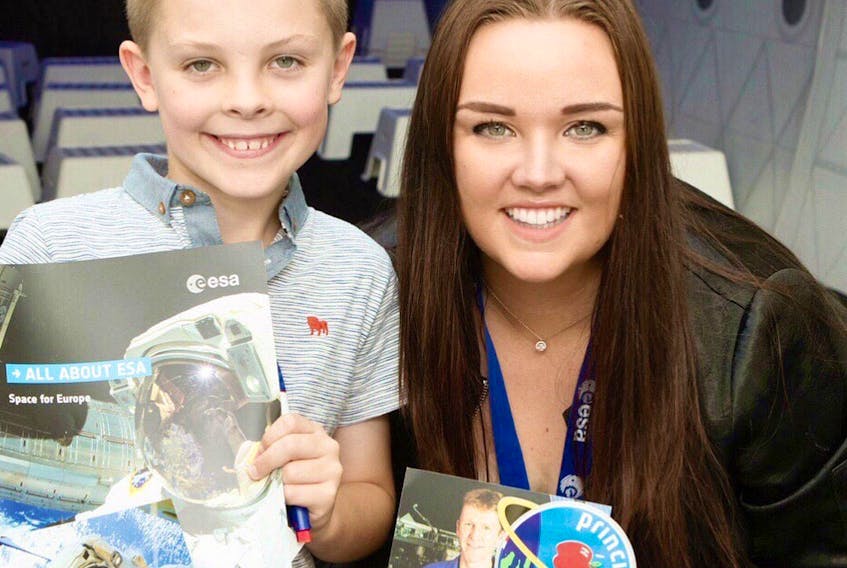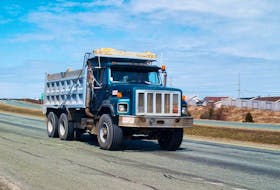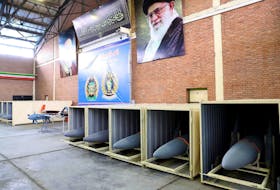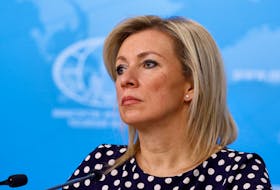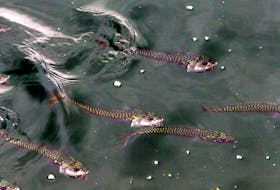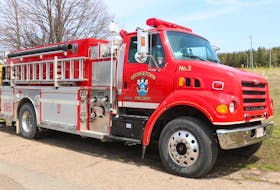Bethany Downer knows a thing or two about rocket science.
The Memorial graduate left her home in 2016 to attend the International Space University (ISU) in Strasbourg, France, to receive a degree in space studies.
Since graduation in September of this year, she has taken up residence in Leiden, The Netherlands, as she considers various prospects within the European space sector in The Netherlands, where the European Space Research and Technology Centre is located.
She still works actively with The Mars Generation and the Space Generation Advisory Council, while managing Reaching Space Science.
On Monday, Dec. 11, Downer will hold a public lecture at the Johnson GEO Centre in St. John’s to discuss exciting new projects in the space sector and a few of her personal industry insights. The lecture, titled Space Exploration’s New Generation, will take place at 7 p.m.
Downer took time from her busy schedule to chat with The Telegram via email regarding her fantastic voyage and answered the following questions.
1. Where are you currently located and why and what are you currently working on?
I am currently living in Leiden, a city just outside Amsterdam, as I am considering various prospects within the European space sector in The Netherlands, where the European Space Research and Technology Centre is located. I still work actively with various organizations. This includes the American non-profit, The Mars Generation, to develop, pilot, and implement various outreach efforts to encourage STEM (science, technology, engineering, and mathematics) interest and involvement in the space sector.
I have also held various roles with the Space Generation Advisory Council, a global non-governmental, non-profit organization and network which aims to represent university students and young space professionals to the United Nations, space agencies, industry, and academia.
I recently assisted in the planning of the first African Space Generation Workshop in Nigeria.
Since moving to Holland I have also founded my own science and technology communication platform for the space industry. Many are intimidated by the term rocket science and thus perceive the industry’s findings, science, and advances as being incomprehensible or beyond public understanding.
Reaching Space Science (https://reachingspacescience.org/) aims to address this by publishing articles about various technology and scientific advances in the space sector. This includes everything from how we communicate through radio waves to spacecrafts travelling through deep space, the chemistry of rocket propulsion, to how the International Space Station filters astronaut urine into potable water. This initiative has amassed thousands of followers on social media and I’m excited to see how it will grow in the coming months.
2. What led you to science?
I completed a BSc at Memorial University in science after having completed the first year of MUN’s engineering program.

I wanted to diversify my academic background, but have always been drawn to science and found that the geography department allowed me to effectively study a variety of domains. This included everything from geomorphology and political geography to completing a three-month study in Alaska to assist with the reintroduction of the wood bison (and a subsequent abstract presentation in Kenya with the department). Throughout this degree I was always reading astrophysics and astronomy textbooks to keep my mind engaged with the space sciences. The International Space University was an easy choice in terms of graduate schools because it allowed me to learn about topics in the industry that I had no particular knowledge of.
In 2014 I founded the non-profit organization One Step Shoe Recycling, which became quite popular in Newfoundland, following a discussion with Canadian astronaut, Commander Chris Hadfield, who encouraged me to make a public platform for myself by doing productive work in the community. This surely worked, as this program sought to educate the public about sustainable consumerism by addressing unwanted footwear we all seem to own. The organization opened offices across Canada and managed to collect almost 20,000 shoes for redistribution to 18 countries worldwide, and retained 15,000 pounds from Canadian landfills. I was very grateful to have been named one of Canada’s Top 30 Under 30 in 2016 and 2017, one of Canada’s Top 25 Under 25 in Sustainability in 2015 and 2016, Memorial University’s Student Leader of the Year with the David Kirkland award in 2016, and Newfoundland and Labrador’s Environmental award in the Individual Category, as a result of this program.
3. Have you ever considered going into space and if so, what would that entail?
I have always been drawn to the adventure of spaceflight, even from a young age. Witnessing a NASA Shuttle launch in 2007 during a family trip to Florida further stimulated this. As the International Space Station’s future is uncertain, traditional astronaut flights will be evolving as new and exciting ventures are explored in the sector. I am not necessarily exclusively determined for the job of being an astronaut for a space agency; being an astronaut on the space station is a demanding job. I would love to be a space tourist by visiting space for just a brief time, at some point during my career.
This is becoming increasingly possible with various companies pursing these possibilities worldwide.
4. Of all the places you have studied, which was the most interesting and why? Was it a particular person, project or just the overall surroundings and processes being carried out there?
My studies at the International Space University surely reassured that this is the sector I was meant to work in. It was hard to leave home to follow this passion, but a very strong family and friend support makes this easier. I completed a communications position with the European Space Agency in Harwell, England and this was surely a valuable experience.
Here I got to work with famed British astronaut, Tim Peake, and to assist the agency in public events in the U.K. Choosing to complete this work term with the European Space Agency (ESA) over NASA was a tough decision, but I am grateful for my choice. ESA is special in that it represents 22 member states, plus associate members (like Canada, which allowed me to intern there). Being part of a dynamic, international work environment and space exploration strategy was very motivating, informative and inspiring.
5. I noticed in a lot of the photos on your website, you are surrounded by children. Is the educational component, something you are in tune with during your past and present ventures?
Education has always been a domain that is part of my family, and to do this as part of my work in the space sector has been a blessing. The reason I am drawn to communication and outreach in the space sector is two-fold. Firstly, it allows me to stay intellectually challenged and engaged with the new technology and science that is emerging in the sector. Secondly, I can then find innovative ways to educate and present this information to various audiences (whether public, prospective investors, students) and to help bring rocket science to a public understanding. Space budgets are very high, and it is important to me to explain to those I speak to at various events that space technologies and services are advancing humans in technological and scientific areas unlike any other, and we rely on this knowledge and applications every day.
6. How long were you at ISU? How different was that experience compared to your Memorial experience … and did it direct you to where you are professionally today?
My four years at Memorial was a valuable academic experience, and allowed me to stay close to family and friends during my studies. My field experience in Alaska and subsequent conference presentation in Kenya was very much a highlight of this degree.

I began my studies at ISU in Strasbourg in September 2016. I completed my internship at ESA during the summer months, and returned in September 2017 for graduation. Of our MSc class of approximately 40 students, we had nearly 25 nationalities. It was a very culturally educative experience to spend everyday with classmates from around the world.
I had never been in a circumstance in which I could discuss current events (whether political, cultural, or space-sector specific) with Russian, French, Dutch, Belgian, Mexican, American, Chinese, Indian, and Canadian classmates all at once. The lectures, international field trips, and assignments covered a broad range of fields within the space domain, including engineering, science, business, law, economics, humanities and satellite applications. This allowed me to meet astronauts and leading representatives of space agencies and industry on a daily basis, and to distinguish what aspects of the space sector are of particular interest for me.
Combined with my work at ESA and additional organizations, ISU has surely established my position in the space sector now, as a young space professional that wants to communicate the science and technology of the industry professionally.
7. What will your lecture at the Geo Centre be focused on?
I worked at the Geo Centre during my undergraduate degree at Memorial and am very excited to be holding a guest lecture on Monday, Dec. 11 at 7 p.m. (doors open 6:30 p.m.). This lecture will provide some personal insights into my experiences and lessons in the space sector. This includes everything from one-on-one conversations with astronauts around the world, shaking hands with Bill Nye at a conference in Australia, and more.
The majority of the talk will talk about what the new and exciting projects of the space sector entail. I will discuss the race to Mars and how SpaceX is helping evolve industry involvement in the sector, the power of space photography, significant scientific advances that have changed our lives on Earth, and European interests in a permanent moon village. I will also hold a Q&A for anyone who wishes to pose any questions about anything discussed.
It’s surely a great way for residents of St. John’s to learn about an industry that isn’t close to us and to be inspired by these activities!
8. What were the outcomes of information you published in your thesis?
ISU is special for requiring both an individual and group thesis projects. My individual project was in the domain of reusable launch vehicles. As the space sector enters a new age of space transportation, exploration, and tourism, there is a growing demand for new vehicles to deliver such needs on a more frequent basis.
To date, a fully reusable launch system has yet to be fully realized. However, due to advancements in materials, engine, and aerospace technology, the concept of reusable launch systems are under steady development (for example; SpaceX, who are actively reusing the first stages of their rockets). My project conducted a parametric cost estimation of reusable launch vehicles to compare the innovation and investment strategies of these commercial projects, to provide insight on their prospective market potential.
This was the first study to compare the cost estimations of reusable vehicle designs that are currently in development. Generally, I concluded that space planes offer an economically promising means of space access in the coming decades, these vehicles take-off and land on a runway similar to the operations of commercial planes.
As the lead editor on a team of 22 (consisting of 13 nationalities), our team project co-operatively produced an extensive report, executive summary, research poster and conference paper over the course of the year. Our project assessed the impact of new and upcoming space-based and space-derived technology solutions on the Corporate Social Responsibility practices of the oil and gas sector. We aimed to recommend ways that the oil and gas sector can improve its work (we assessed according to environmental impact, labour and operation practices, and social impact) through the implementation of various space technologies.
It was clear that space technologies and knowledge, including analog studies and new satellite constellations, can improve the way the oil and gas sector operates. For example, various ways astronauts and employees in remote oil extraction locations (such as oil rigs) are similar: isolation, restricted communication to family, risky tasks, close living quarters, etc.
As a result of these projects, I presented three papers at the 67th International Astronautical Congress in Adelaide, Australia in September. This was my first time to Australia, during which I got to experience the region’s wineries, wildlife and culture.
The conference is the largest gathering of representatives of the space industry annually, ranging from students, professionals, agency heads, to senior executives of the world’s space agencies.
In addition to presenting and publishing three papers at the congress, the highlight of the conference was surely shaking hands with Bill Nye (The Science Guy) following his presentation on solar sail technology, and witnessing Elon Musk (CEO of SpaceX and Tesla) reveal his new plans for colonizing Mars in person.
9. Everyone has a plan. What have you set out for yourself for the short-term and long-term in your career?
I am definitely working in the right sector, and I’m excited to see how my career grows. I’m only 23, and I am extremely grateful for what I have seen and experienced so far. I have travelled around the world and have worked with leading professionals in their respective domains of the field. I consider myself the luckiest for having the most supportive, loving, and encouraging family back in St. John’s that I can visit whenever I want. I hope to continue to build my career in the areas of technology and science writing and communication for the space sector. I definitely see an end goal of space flight and/or achieving a public platform similar of a female Bill Nye (I hope!).
Personal Highlights
The following is a brief list of some of Bethany Downer’s career highlights:
• Featured in Canada's 30x30 Guide: Class of 2017 — Top 30 Under 30 (Link)
• Awarded the Alpha Centauri Prize for Individual Thesis Project at the International Space University 2017
• Named one of Canada’s Top 30 Under 30 in 2016 (Link)
• Named Memorial University’s Student Leader of The Year — The David Kirkland Student Leadership Award 2016 (Link)
• Named twice to Canada’s Top 25 Under 25 in Sustainability 2015 and 2016 (Link 1/Link 2)

